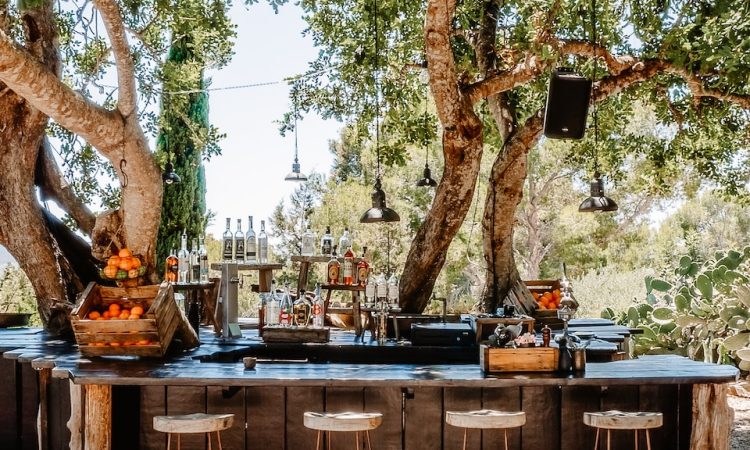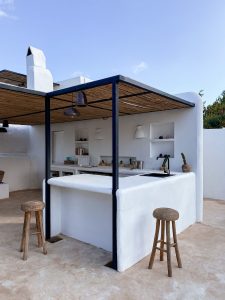Welcome to the complete guide on creating an outdoor kitchen! If you’re someone who loves entertaining and enjoying the great outdoors, an outdoor kitchen can be a fantastic addition to your home. It allows you to cook, dine, and socialize in the fresh air, creating memorable experiences for your friends and family. In this comprehensive guide, we’ll take you through each step of the process, from planning and design to installation and maintenance. So let’s dive in and discover how you can create your very own outdoor kitchen oasis!
Planning Your Outdoor Kitchen
Before you start building your outdoor kitchen, it’s important to plan every detail carefully. This will ensure that you make the most of your space and create a functional and beautiful outdoor cooking area.
Assess Your Needs and Space
The first step in planning your outdoor kitchen is to assess your needs and available space. Ask yourself questions like:
- How often will you use the outdoor kitchen?
- How many people will you typically cook for?
- What appliances and features are essential to you?
- Do you have enough space for the kitchen you envision?
Set a Realistic Budget
Setting a realistic budget is crucial for any home improvement project, including an outdoor kitchen. Determine how much you’re willing to spend and allocate funds to different components such as appliances, materials, and labor. Remember to leave some room for unexpected expenses that may arise during the construction process.
Consider Your Climate
Take into account your local climate when planning your outdoor kitchen. If you live in an area with harsh winters, you’ll need to choose materials and appliances that can withstand the elements. Additionally, consider shade options like pergolas or umbrellas to protect yourself from the sun during hot summer days.
Designing Your Outdoor Kitchen
Once you’ve completed the planning phase, it’s time to move on to the exciting part – designing your outdoor kitchen. This is where you can let your creativity shine and create a space that reflects your personal style and preferences.
Choose a Layout
The layout of your outdoor kitchen will depend on the available space and your specific needs. Here are a few popular layout options to consider:
- L-Shaped Kitchen: This layout is versatile and works well for both small and large spaces. It provides ample counter space and allows for easy movement between different cooking stations.
- U-Shaped Kitchen: Ideal for larger areas, a U-shaped layout offers plenty of countertop space and creates a more enclosed cooking area.
- Island Kitchen: Perfect for entertaining, an island kitchen allows for a more open layout and provides a central focal point for gathering and socializing.
Select the Right Appliances
Choosing the right appliances for your outdoor kitchen is essential for creating a functional cooking space. Here are some popular appliances to consider:
- Grill: The centerpiece of any outdoor kitchen, a high-quality grill is a must-have for cooking delicious meals.
- Outdoor Oven: If you enjoy baking or want the option to cook with indirect heat, consider adding an outdoor oven to your kitchen.
- Refrigerator: Keep your ingredients fresh and beverages cool with an outdoor refrigerator. Look for one with weatherproof features to ensure durability.
- Sink: A sink is a convenient addition to any outdoor kitchen, allowing you to wash and prep food without having to go inside.
Choose Durable and Weather-Resistant Materials
Since your outdoor kitchen will be exposed to the elements, it’s crucial to choose materials that can withstand different weather conditions. Opt for materials like stainless steel, stone, or tile that are durable, easy to clean, and resistant to heat and moisture.
Building Your Outdoor Kitchen
Now that you have a well-thought-out design, it’s time to bring your outdoor kitchen to life. Building an outdoor kitchen may involve various tasks, and depending on your skills and comfort level, you may choose to do it yourself or hire professionals.
DIY or Hire Professionals?
Decide whether you want to take on the project yourself or hire professionals to handle the construction. While a DIY approach can be rewarding, it requires time, skills, and knowledge of building codes. If you’re not confident in your abilities, hiring professionals ensures a smoother and safer construction process.
Obtaining Necessary Permits
Before you begin construction, check with your local authorities to determine if you need any permits or approvals for your outdoor kitchen. Failing to obtain the necessary permits can result in fines or even having to dismantle your kitchen.
Assemble and Install
If you’re assembling prefabricated outdoor kitchen units, follow the manufacturer’s instructions carefully. Ensure proper installation of appliances, including gas and electrical connections, to ensure safety and functionality. If you’re building from scratch, consult with professionals to ensure your construction meets all necessary requirements.
FAQs about Creating an Outdoor Kitchen
Q: How much does it cost to create an outdoor kitchen?
A: The cost of creating an outdoor kitchen can vary widely depending on factors such as the size, materials used, appliances chosen, and the level of customization. On average, you can expect to spend between $5,000 and $20,000 for a basic setup, while elaborate designs with high-end appliances can exceed $50,000.
Q: Do I need a professional designer for my outdoor kitchen?
A: While hiring a professional designer is not mandatory, it can greatly benefit your outdoor kitchen project. Designers have the expertise to maximize your space, offer innovative ideas, and ensure that your kitchen meets all your functional and aesthetic requirements.
Q: Can I use my indoor appliances in an outdoor kitchen?
A: Most indoor appliances are not designed for outdoor use and may not withstand the elements. Outdoor appliances are specifically built to be weatherproof and durable, ensuring safe operation and longevity in outdoor conditions.
Q: How do I maintain my outdoor kitchen?
A: Regular maintenance is key to keeping your outdoor kitchen in top shape. Clean the grill and other appliances regularly, wipe down countertops, and check for any signs of wear or damage. Cover your kitchen when not in use, especially during harsh weather conditions.
Q: Can I add additional features to my outdoor kitchen over time?
A: Absolutely! One of the great advantages of an outdoor kitchen is its versatility. You can start with a basic setup and gradually add features like a pizza oven, outdoor bar, or fire pit as your budget and needs allow.
Q: What are some safety considerations for outdoor kitchens?
A: When building your outdoor kitchen, ensure proper ventilation for gas appliances, use non-slip flooring to prevent accidents, and install adequate lighting for visibility during nighttime cooking. Follow safety guidelines for electrical and gas connections, and always have a fire extinguisher nearby.
Conclusion
Congratulations on reaching the end of our complete how-to guide on creating an outdoor kitchen! We hope this comprehensive resource has provided you with valuable insights and inspiration for your outdoor culinary haven. Remember to plan carefully, design thoughtfully, and choose durable materials and appliances to ensure a functional and enjoyable outdoor cooking experience. So go ahead and start creating your dream outdoor kitchen, and get ready to savor countless delicious meals under the open sky!


